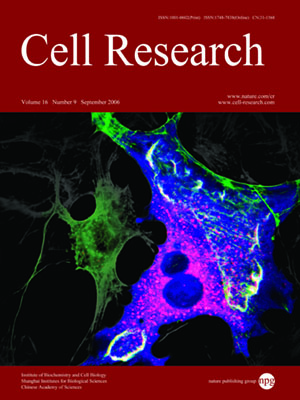
Volume 16, No 9, Sep 2006
ISSN: 1001-0602
EISSN: 1748-7838 2018
impact factor 17.848*
(Clarivate Analytics, 2019)
Volume 16 Issue 9, September 2006: 780-796
ORIGINAL ARTICLES
Transcription of the putative tumor suppressor gene HCCS1 requires binding of ETS-2 to its consensus near the transcription start site
Jing De Zhu, Qi Fei, Peng Wang, Fei Lan, Da Qin Mao, Hong Yu Zhang, Xue Biao Yao
1Laboratory of Cancer Epigenetics and Gene Therapy, The State-Key Laboratory for Oncogenes and Related Genes, Shanghai Cancer
Institute, Shanghai Jiaotong University, LN 2200/25, Xietu Road, Shanghai 200032, China; 2School of Life Sciences, Zhejiang Science
and Technology University, Xiasha University District, Hangzhou, Zhejiang 310018, China; 3Laboratory of Cellular Dynamics,
University of Science and Technology of China, Hefei 230027, China
Correspondence: Jing De Zhu(zhujingde@yahoo.com)
The hepatocellular carcinoma suppressor 1 (HCCS1) gene was identified by both positional cloning from a predominant
region of loss of heterozygosity (17p13.3) in liver cancer and by functional screening for genes affecting cell proliferation
in large-scale transfection assays. Its overexpression results in inhibition of cell proliferation in cell culture and tumor
growth in nude mice. To understand its transcription regulation, the promoter architecture has been dissected in detail. The
major start of transcription was mapped by primer extension to a C residue, 177 nucleotides upstream of the ATG codon.
By assessing the promoter activity of a set of linker-scanning mutants of the minimal promoter (–60 to +148 region) in
a transient transfection assay, we found that the +1 to + 40 region is critical to HCCS1 gene transcription, containing
binding sites for transcription factors NF-κB (–21 to +7 and +40 to +26), p53 (+29 to +9) and ETS (+4 to +20 and +23
to +39). Biochemical and molecular analyses revealed that the ETS transcription factors ETS-2 and Elf-1 bind to the
two ETS sites in situ and contribute significantly to the transcriptionally active state of the HCCS1 gene, while NF-κB,
p53 and two other members of the ETS family (ETS-1 and NERF2) appear to play little role. Our observations provide
insight into the mechanistic aspects of HCCS1 transcription regulation
Cell Research (2006) 16:780-796. doi: 10.1038/sj.cr.7310092; published online 5 Sep 2006
FULL TEXT | PDF
Browse 1913


